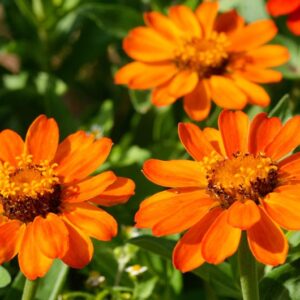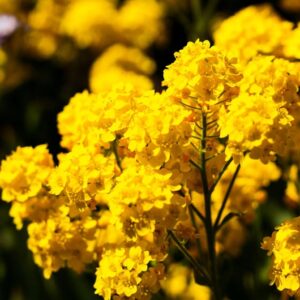
From the captivating hues of Petunias to the intricate designs of Paphiopedilums, the world of flowers that start with P is a spectacular adventure in botany. As we journey through this vibrant tapestry of colors, textures, and forms, we find a dazzling array of flowers that inspire wonder and bring life to our gardens.
In this article, we will explore 37 remarkable flowering plants that begin with the letter ‘P’, showcasing their unique characteristics and revealing their remarkable beauty.
1. Petunia

Image source: Pinterest
A favorite amongst gardeners, Petunias offer vibrant colors ranging from pure white to deep purple. These flowering plants, native to South America, can thrive in various climates and settings, making them a versatile choice for gardeners looking for a resilient and beautiful flower. They are also renowned for their trumpet-like shape and pleasing scent.
2. Primula

Image source: Pinterest
Known for their early spring blooms, Primulas or Primroses offer a burst of color after winter’s chill. These low-growing perennials prefer cooler climates and moist, well-drained soil, making them a popular choice for woodland gardens. Their delicate, bell-shaped flowers can come in a variety of colors, including yellow, red, pink, and blue.
3. Paphiopedilum

Image source: Pinterest
Often referred to as the “Venus slipper”, Paphiopedilums are a type of orchid known for their distinct slipper-shaped pouches. These tropical beauties thrive in warm, humid environments and are admired for their unique, intricate patterns and long-lasting blooms.
4. Pansy

Image source: Pinterest
Pansies are cherished for their charming, face-like flowers and vast array of colors. These annual or short-lived perennial plants are perfect for adding a splash of color to borders, containers, or as ground cover. Hardy and versatile, Pansies can thrive in a variety of climates.
5. Peony

Image source: Pinterest
Renowned for their lush, full-bodied blooms, Peonies are a classic garden staple. These hardy perennials have been cultivated for centuries for their large, fragrant flowers and attractive foliage. They require cold winters to bloom and come in a range of colors from pure white to deep maroon.
6. Papaver (Poppy)

Image source: Pinterest
Poppies are known for their silky, papery flowers that can brighten up any garden. These annual or perennial plants are native to various parts of the world, with colors ranging from the classic vibrant red to soft pink, white, and even deep purple.
7. Phlox

Image source: Pinterest
These perennial plants are cherished for their clusters of small, star-shaped flowers and pleasant fragrance. They are available in a variety of forms, from creeping phlox perfect for ground cover to tall phlox that’s great for borders.
8. Passiflora (Passion Flower)

Image source: Pinterest
Known for their intricate, exotic flowers, Passion Flowers are vines that are often grown on trellises or fences. Their unique blooms, which come in many different colors and designs, are a stunning addition to any garden.
9. Plumeria

Image source: Pinterest
Famous for their use in Hawaiian leis, Plumeria are tropical trees or shrubs that produce fragrant, vibrant flowers. Though not frost-hardy, they can be grown in containers and moved indoors during colder months in cooler climates.
10. Polygonatum (Solomon’s Seal)

Image source: Pinterest
Solomon’s Seal is a genus of woodland plants characterized by their arching stems and graceful, dangling flowers. The tubular, bell-shaped flowers usually appear in spring or early summer and come in shades of white, green, or yellow. After the flowers fade, black or blue berries develop along the stem, adding visual interest to the plant.
11. Pelargonium (Geraniums)

Image source: Pinterest
The Geranium, or Pelargonium, is an abundantly flowering plant that’s commonly seen in window boxes, containers, and hanging baskets. These versatile plants bloom from summer through fall in a broad array of colors such as red, pink, white, purple, and even bicolor varieties. The Geranium’s aromatic foliage also adds to its charm, offering scents ranging from rose to lemon and even chocolate.
12. Persicaria (Knotweed)

Image source: Pinterest
Persicaria, also known as Knotweed, is a genus of flowering plants that produces tiny, tightly-clustered flowers. The pink, white, or red flowers are often spike-like, providing a lovely contrast against their rich green foliage. While some Knotweed species can be invasive, others are used for ornamental purposes due to their ability to fill spaces and create colorful ground cover.
13. Phacelia

Image source: Pinterest
Also referred to as Scorpionweed, Phacelia is a beautiful, fast-growing flower recognized for its captivating blue or violet blooms that form curled clusters, similar to a scorpion’s tail. It’s a great source of nectar, attracting bees and other beneficial insects, making it a popular choice for organic farming as a cover crop.
14. Philadelphus (Mock-Orange)

Image source: Pinterest
Philadelphus, commonly known as Mock-Orange due to its sweetly scented blooms that resemble those of orange trees, is a deciduous shrub that flowers in late spring to early summer. The flowers are usually white, with a refreshing fragrance that fills the surrounding air, adding a sensory treat to any garden.
15. Phlomis

Image source: Pinterest
Phlomis is a genus of perennial plant known for its hooded, yellow to purple flowers. The flower clusters are arranged in whorls around the stem, offering a unique structure that makes Phlomis a standout in any garden. The leaves are typically textured and heart-shaped, adding to the plant’s ornamental value.
16. Physostegia (Obedient Plant)

Image source: Pinterest
The Obedient Plant, or Physostegia, gets its name from the way its flowers stay in place when moved, making it a favorite among flower arrangers. This plant produces spiky inflorescences of tubular, pink to purple flowers, which are a magnet for hummingbirds. They enjoy a long bloom time from mid to late summer and thrive in full sun to partial shade.
17. Pieris

Image source: Pinterest
Pieris is an evergreen shrub known for its chains of small, bell-shaped flowers that bloom in early spring. Its flower color varies from white to pink, often offering a lovely contrast to the bronze-red new growth of its leaves. The Pieris is a fantastic early food source for bees and other pollinators.
18. Polemonium (Jacob’s Ladder)

Image source: Pinterest
Polemonium, also known as Jacob’s Ladder, gets its name from the evenly spaced, ladder-like arrangement of its leaves. It produces clusters of bell-shaped flowers that are typically blue but can also be pink or white. This low-maintenance plant thrives in partially shaded areas with well-drained soil.
19. Polianthes (Tuberose)

Image source: Pinterest
Polianthes, or Tuberose, is treasured for its heavily scented, waxy white flowers. Native to Mexico, this perennial bulb puts out tall spikes of fragrant blooms in late summer, and is often used in the perfume industry due to its intensely sweet, heady fragrance.
20. Potentilla

Image source: Pinterest
Potentilla is a hardy perennial that produces cheerful, five-petaled flowers in a wide variety of colors such as white, yellow, pink, and red. It’s a resilient plant, able to tolerate poor soil conditions and drought, making it a common choice for rock gardens and borders.
21. Primula veris (Cowslip)

Image source: Pinterest
The Cowslip, a close cousin of the primrose, is a delightful spring-blooming plant. It displays clusters of small, bell-shaped yellow flowers that hang down from tall stems. The Cowslip is a valuable source of nectar for insects and can often be found in traditional English meadows.
22. Pseudofumaria lutea (Yellow Corydalis)

Image source: Pinterest
Yellow Corydalis is a perennial plant that’s native to the Alps and is often found growing in the cracks of walls or pavements. It produces clusters of tubular, yellow flowers and its delicate, fern-like foliage remains attractive all year round, providing a lovely backdrop to other flowers in a rock garden or border.
23. Pulmonaria (Lungwort)

Image source: Pinterest
Pulmonaria, also known as Lungwort, is one of the earliest perennial plants to flower in the spring, producing clusters of flowers that change color from pink to blue or white as they mature. Its dark green leaves are dotted with white spots, adding further interest to this shade-loving plant.
24. Pulsatilla vulgaris (Pasqueflower)

Image source: Pinterest
The Pasqueflower is an enchanting spring flower that blooms around Easter, hence its name (“Pasque” is Old French for Easter). It produces bell-shaped flowers that range in color from purple and pink to white. The flowers are followed by equally attractive seed heads, which look like fluffy pompoms.
25. Papaver orientale (Oriental Poppy)

Image source: Pinterest
Known for their large, vibrant blooms, Oriental Poppies are perennial plants that are commonly grown in flower borders and beds. Their striking colors, ranging from white and pink to deep red and orange, create a beautiful contrast with their dark center.
26. Parkinsonia aculeata (Jerusalem Thorn)

Image source: Pinterest
Jerusalem Thorn, also known as Parkinsonia, is a small deciduous tree or shrub native to South America. It showcases intricate, yellow, fragrant flowers, usually in clusters, that bloom in late spring or early summer. Jerusalem Thorn is valued for its feathery foliage, vibrant flowers, and drought tolerance, making it a suitable choice for arid and desert-like landscapes.
27. Parthenium integrifolium (Wild Quinine)

Image source: Pinterest
Wild Quinine is a North American native perennial herb known for its clusters of small, white flowers. These flowers, held on upright stems, add a touch of elegance to prairie gardens and wildflower meadows. Beyond its ornamental value, Wild Quinine has historically been used for medicinal purposes. It thrives in dry, well-drained soils, making it an excellent choice for xeriscaping or pollinator gardens.
28. Paulownia tomentosa (Princess Tree)

Image source: Pinterest
The Princess Tree, or Paulownia, is a fast-growing deciduous tree that captivates with its large, heart-shaped leaves and showy clusters of fragrant, purple flowers. These flowers appear in spring before the tree’s foliage emerges, creating a stunning visual display.
29. Penstemon (Beardtongue)

Image source: Pinterest
Penstemon, commonly known as Beardtongue, is a diverse genus of flowering plants, comprising over 250 species. These perennials are admired for their tubular flowers that come in an array of colors, including shades of pink, red, purple, blue, and white. Many Penstemon species are attractive to pollinators, particularly hummingbirds.
30. Pentas lanceolata (Egyptian Starcluster)

Image source: Pinterest
Egyptian Starcluster, or Pentas, is a tropical plant known for its clusters of star-shaped flowers in shades of pink, red, white, and lavender. These nectar-rich flowers attract butterflies, bees, and hummingbirds, making them a delightful addition to pollinator gardens. Pentas is valued for its long blooming period, drought tolerance, and low maintenance requirements.
31. Perovskia atriplicifolia (Russian Sage)

Image source: Pinterest
Russian Sage is a perennial plant highly regarded for its delicate, lavender-blue flowers that appear on long, arching spikes. These flowers add a touch of ethereal beauty to gardens and landscapes, particularly in late summer and early fall. Russian Sage is prized for its silvery-gray foliage and its ability to thrive in hot, dry conditions.
32. Phygelius (Cape Fuchsia)

Image source: Pinterest
Phygelius, commonly known as Cape Fuchsia, is a genus of flowering perennials originating from South Africa. They produce tubular flowers in shades of red, pink, and yellow, resembling those of fuchsias. These long-blooming plants are loved for their vibrant colors, attractive foliage, and their ability to attract hummingbirds.
33. Platanthera (Fringed Orchid)

Image source: Pinterest
Platanthera is a genus of orchids commonly referred to as Fringed Orchids. These orchids are known for their intricate and fragrant flowers. The blooms typically feature delicate, fringed petals and come in various colors such as white, green, yellow, or purple. They are native to temperate regions of the Northern Hemisphere and are admired for their beauty and rarity.
34. Podranea ricasoliana (Pink Trumpet Vine)

Image source: Pinterest
Pink Trumpet Vine, also known as Podranea, is a vigorous climbing vine appreciated for its cascading clusters of trumpet-shaped, pink flowers. These eye-catching blooms add a touch of tropical beauty to gardens, walls, or trellises. Pink Trumpet Vine is a resilient plant that thrives in full sun and warm climates. It’s commonly grown for its abundant and long-lasting flowering season, which extends from late spring to fall.
35. Plectranthus (Spur Flower)

Image source: Pinterest
The Plectranthus genus contains over 350 species, many of which are known for their vibrant and aromatic foliage. Some species produce tall spikes of flowers in shades of white, blue, purple, or pink. These plants are often used in hanging baskets or as ground cover in subtropical climates.
36. Polygala (Milkwort)

Image source: Pinterest
Milkworts are evergreen shrubs or herbaceous perennials, known for their pea-like flowers, which come in a variety of colors including pink, purple, and yellow. Some species are used in traditional medicine.
37. Primula obconica (Poison Primrose)

Image source: Pinterest
Despite its name, the Poison Primrose is a beautiful plant with clusters of pastel-colored flowers. It earned its name from the fact that its sap can cause skin irritation in some people. Nevertheless, it’s popular as an indoor flowering plant.


